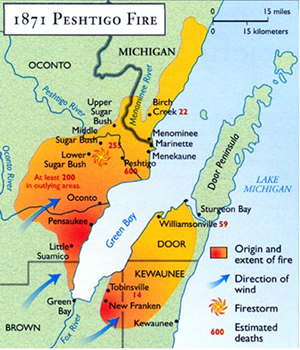On the night of October 8, 1871, a long dry spell ended as strong depression and wild winds spread across the Midwest. There were two large fires that night. One was in Chicago where, as the tall-tale would have it, Mrs O'Leary's cow supposedly kicked over a lantern, starting a massive fire that ultimately killed 300 people. The Great Chicago Fire remains famous. The other fire is remembered less frequently; centered on the logging town of Peshtigo, Wisconsin, north of Green Bay, that fire burnt out an area the size of Delaware and killed between 1,200 and 2,500 people, the largest loss of life in any fire in American history.
 The logging industry left discarded wood and timber everywhere in the area, which served as kindling. Though the source of the fire is unknown, once started, the strong winds aided its development and spread, creating a firestorm. Approximately half the population of Peshtigo perished (500-800 people), while at least a dozen other settlements were burned to the ground. Peshtigo burned in less than an hour, with many of the survivors seeking refuge in the nearby river, along with panicked domestic and wild animals.
The logging industry left discarded wood and timber everywhere in the area, which served as kindling. Though the source of the fire is unknown, once started, the strong winds aided its development and spread, creating a firestorm. Approximately half the population of Peshtigo perished (500-800 people), while at least a dozen other settlements were burned to the ground. Peshtigo burned in less than an hour, with many of the survivors seeking refuge in the nearby river, along with panicked domestic and wild animals.
Because of the remoteness of the region, it took days for help to arrive.
This article, published by the local paper on the 50th anniversary of the fire, contains more details.
The short video below provides a good summary of that horrible night.
No comments:
Post a Comment